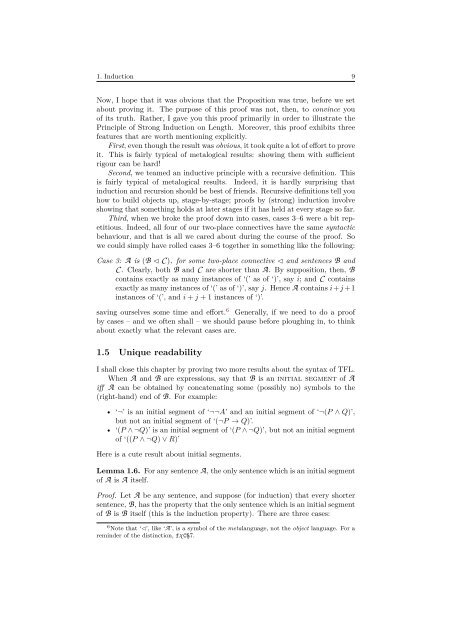Metatheory - University of Cambridge
Metatheory - University of Cambridge
Metatheory - University of Cambridge
Create successful ePaper yourself
Turn your PDF publications into a flip-book with our unique Google optimized e-Paper software.
1. Induction 9<br />
Now, I hope that it was obvious that the Proposition was true, before we set<br />
about proving it. The purpose <strong>of</strong> this pro<strong>of</strong> was not, then, to convince you<br />
<strong>of</strong> its truth. Rather, I gave you this pro<strong>of</strong> primarily in order to illustrate the<br />
Principle <strong>of</strong> Strong Induction on Length. Moreover, this pro<strong>of</strong> exhibits three<br />
features that are worth mentioning explicitly.<br />
First, even though the result was obvious, it took quite a lot <strong>of</strong> effort to prove<br />
it. This is fairly typical <strong>of</strong> metalogical results: showing them with sufficient<br />
rigour can be hard!<br />
Second, we teamed an inductive principle with a recursive definition. This<br />
is fairly typical <strong>of</strong> metalogical results. Indeed, it is hardly surprising that<br />
induction and recursion should be best <strong>of</strong> friends. Recursive definitions tell you<br />
how to build objects up, stage-by-stage; pro<strong>of</strong>s by (strong) induction involve<br />
showing that something holds at later stages if it has held at every stage so far.<br />
Third, when we broke the pro<strong>of</strong> down into cases, cases 3–6 were a bit repetitious.<br />
Indeed, all four <strong>of</strong> our two-place connectives have the same syntactic<br />
behaviour, and that is all we cared about during the course <strong>of</strong> the pro<strong>of</strong>. So<br />
we could simply have rolled cases 3–6 together in something like the following:<br />
Case 3: A is (B ◁ C ), for some two-place connective ◁ and sentences B and<br />
C . Clearly, both B and C are shorter than A. By supposition, then, B<br />
contains exactly as many instances <strong>of</strong> ‘(’ as <strong>of</strong> ‘)’, say i; and C contains<br />
exactly as many instances <strong>of</strong> ‘(’ as <strong>of</strong> ‘)’, say j. Hence A contains i+j +1<br />
instances <strong>of</strong> ‘(’, and i + j + 1 instances <strong>of</strong> ‘)’.<br />
saving ourselves some time and effort. 6 Generally, if we need to do a pro<strong>of</strong><br />
by cases – and we <strong>of</strong>ten shall – we should pause before ploughing in, to think<br />
about exactly what the relevant cases are.<br />
1.5 Unique readability<br />
I shall close this chapter by proving two more results about the syntax <strong>of</strong> TFL.<br />
When A and B are expressions, say that B is an initial segment <strong>of</strong> A<br />
iff A can be obtained by concatenating some (possibly no) symbols to the<br />
(right-hand) end <strong>of</strong> B. For example:<br />
• ‘¬’ is an initial segment <strong>of</strong> ‘¬¬A’ and an initial segment <strong>of</strong> ‘¬(P ∧ Q)’,<br />
but not an initial segment <strong>of</strong> ‘(¬P → Q)’.<br />
• ‘(P ∧ ¬Q)’ is an initial segment <strong>of</strong> ‘(P ∧ ¬Q)’, but not an initial segment<br />
<strong>of</strong> ‘((P ∧ ¬Q) ∨ R)’<br />
Here is a cute result about initial segments.<br />
Lemma 1.6. For any sentence A, the only sentence which is an initial segment<br />
<strong>of</strong> A is A itself.<br />
Pro<strong>of</strong>. Let A be any sentence, and suppose (for induction) that every shorter<br />
sentence, B, has the property that the only sentence which is an initial segment<br />
<strong>of</strong> B is B itself (this is the induction property). There are three cases:<br />
6 Note that ‘◁’, like ‘A’, is a symbol <strong>of</strong> the metalanguage, not the object language. For a<br />
reminder <strong>of</strong> the distinction, fx C§7.
















